XXI Olympic Winter Games |
|
|

|
We made it to the Olympics! Those who follow our page may recall that in
October 2008 we were in Beijing, and
commented, "We got to Beijing 2 months after The Summer Games. That's a new Olympic record
for us ... normally we miss them by several years." This time, we got to Vancouver
on time, earning us a gold medal in Calendar!

|
|
|
| Party Time |
The Winter Olympics were both sports and a huge party. Many streets in
downtown Vancouver were blocked off, and people wandered around chatting, enjoying
the sun, and visiting the many cultural exhibits. Even the Stanley Cup qualified as a "cultural"
exhibit.

|
|
|
| Nunavut |
One of the best exhibits came from Nunavut, the Arctic territory of Canada
populated by native peoples. Both the art and natural history were highlighted in this stone carving
of a hunter fighting a bear over a seal, speared by a beautifully carved narwal tusk.
The huge Mastodon tusk recalled the Olympian winters of the Ice Age. And
the charming Enchanted Owl is a graphic used on a 1970 Canadian postage stamp by Nunavut artist
Kenojuak Ashevac.
|
|
|
|
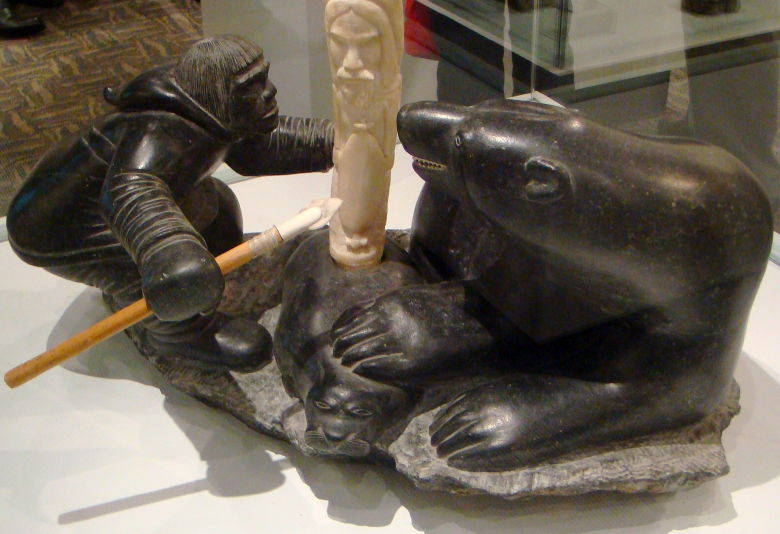
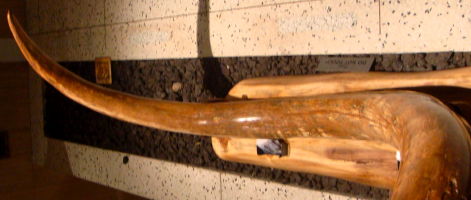 x x
|
|
|
| |

|
|
|
| Women's Curling |
Of course, the point of the Olympics is World Class competition. We chose to
watch curling, as true a Canadian sport as hockey is. We saw an
especially good selection of teams.
| Canada v. China |
| Japan v. Germany |
| USA v. Sweden |
We were cheering for the first team on each line. As Dave put it,
"Cheering for the 'home' country!" Can you pick out the 4-woman teams by their uniforms?
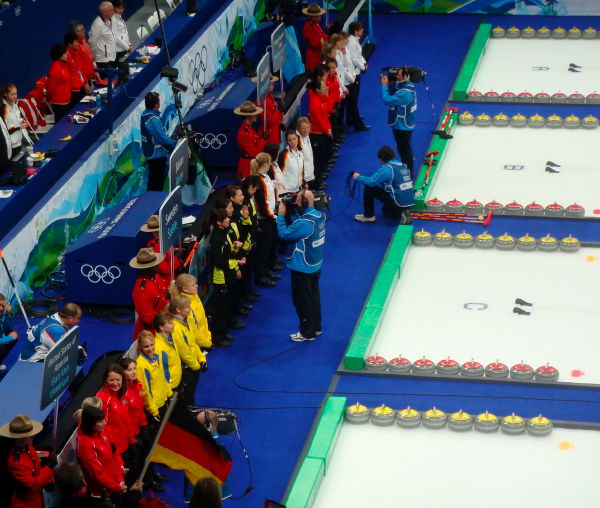
|
|
|
| It's Strategic! |
The goal in curling is to win the most points in the ten ends
of a regulation game. Unlike shuffleboard, in which the disks travel in a straight line, curling
stones -- listen closely -- curl. They travel the length of the sheet
(ice) in an arc, and there is considerable strategy. Here in a close
call to award a point, an official determines which team's rock is
closest to the button (bull's eye).

|
|
|
| Throwing Rocks |
To throw a 42 lbs (19 kg) stone, a curler places one foot against the hack (the black starting
block) and uses her broom for balance.
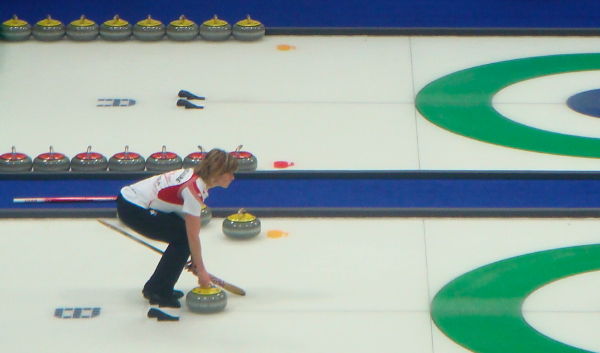
She pushes off ...
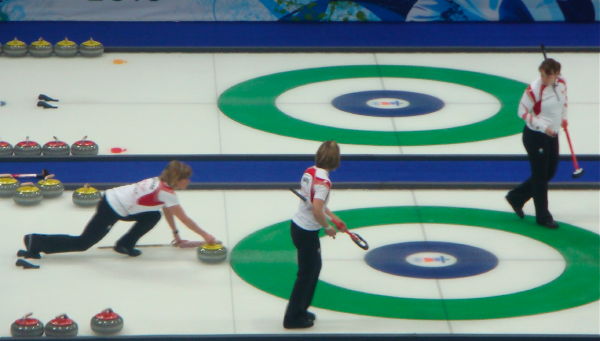
... and slides on her front shoe. She must release the rock before crossing the hog line.
As she releases it she twists it so it revolves about 2.5 times down the ice, causing the curl.
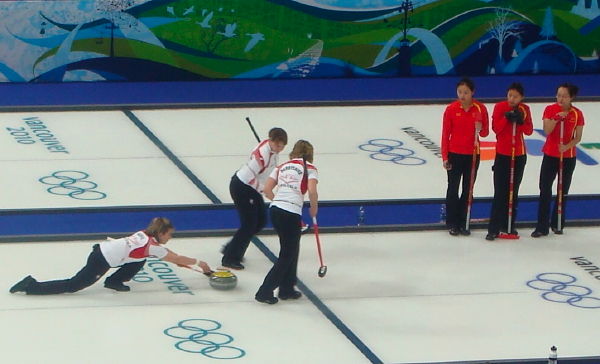
|
|
|
| Sweeping |
To understand sweeping, you need to know that the ice is not smooth -- it is pebbled
(sprinkled with water droplets) and the bottom of a rock is concave, so very little of the rock touches
the ice. Sweeping furiously causes a thin layer of water to develop on the pebbles, keeping the stone
from slowing, that is, it travels farther.
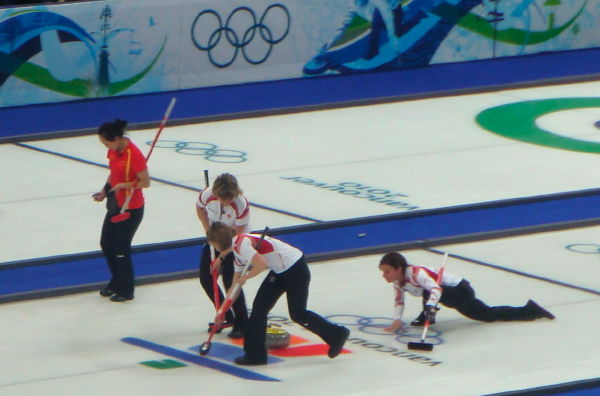
As Canada sweeps a Chinese sweeper checks her text messages.
|
|
|
| Intensity |
Everyone told us that curling is a social game. People play it to win, of course, but they drink beer and chat
with their opponents. At the Olympics, it seemed to be different. The players were extremely intense.
This player -- Allison Pottinger from Minneapolis -- shows that intensity as she throws, but you should have seen
the Chinese women!

|
|
|
| Winners & Losers |
Unfortunately for us, Sweden crushed the USA 9-3. It was so bad they didn't bother to play the
last two ends. Also unfortunately, Germany squeaked by Japan 7-6. Japan was far behind at one point
and almost caught up. And Canada and China were tied at the end of the regulation 10 ends. So
they played extra ends.

Here, the Canadian coach is discussing with his team an important strategic point, while the Chinese
women wait. The guy in green is a referee, and he came out to tell the coach to finish up.
|
|
|
| Game Over |
And ... unfortunately ... China beat Canada in "extra ends" 6-5.
The final results of all Women's Curling Competition:
| Gold: Sweden |
| Silver: Canada |
| Bronze: China |
So, although we didn't see the finals, we did see all of the winning teams play!
|
|
|
| Post Game |
And what about the Zamboni -- the famous machine that resurfaces ice rinks?
It's curling, and so everything is on a smaller scale. Behind us, a man is carrying the equipment
to clean the curling surface. It's pushed by hand, as seen in the distance.
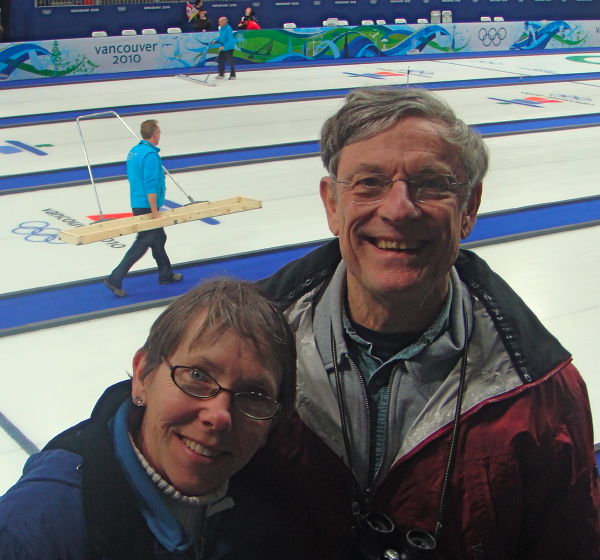
|
|
|